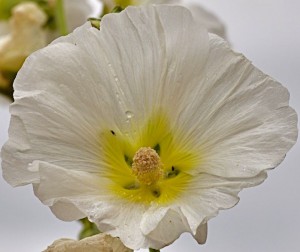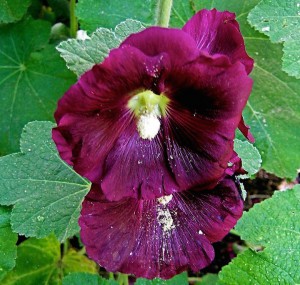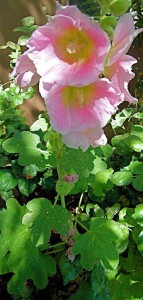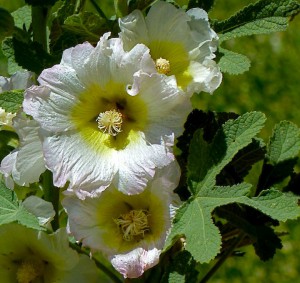
Photo: Janice Tucker
Scientific name: Alcea rosea
Common name: Hollyhock
Family: Malvaceae
Article by Susan Bruneni
Photos by Janice Tucker
The image of vibrantly colored hollyhocks, adobe walls and bright blue skies is a distinct characteristic of northern New Mexico today. But the scene has been the same since the earliest Spanish settlers planted their fields. When Juan de Oñate headed north along the Rio Grande with a party of settlers, livestock, and Old World plants, tiny hollyhock seeds they called Las Varas de San Jose (St. Joseph’s staff) were tucked in with their supplies. The Spanish believed these plants brought good luck from St. Joseph. And they proved they indeed brought good luck by their ability to flourish in the harsh northern New Mexico climate when other plants could not survive.

Photo: Janice Tucker
Alcea, is a genus of about 60 species of flowering plants in the mallow family Malvaceae. They are native to Asia but are highly adaptable to different climates and are now found throughout the United States and eastern Canada. They were first mentioned in England in “Grete Herbal” by John Gerard in 1597 as arriving in Britain in 1573, probably from China by way of Palestine.
Hollyhocks are biennial, or sometimes short-lived perennials, growing four to eight feet high with a one to two foot spread. Plants produce foliage their first year, flowers the second year and then die off. Depending on the individual plant, they may live for five to seven years. Fortunately, they re-seed easily, so plants will continually grow anew in the same location. They thrive in full sun or part shade in well-drained soil.
The name hollyhock is derived from the Anglo-Saxon term “holy-hoc” or holy mallow because it came from the Holy Land (Palestine).They were introduced in Spain at an earlier date and were usually represented in paintings of St. Joseph. They were then brought with settlers to Mexico and New Mexico. Our local hollyhocks are descended from the first to be planted in what is now the U.S.
Elizabeth Blackwell stated in “A Curious Herbal” (1751): 1. This plant grows six or seven foot high; the leaves are a light green and the Flowers a pale Red. 2. It grows in Garden and flowers in July and August. 3. Hollyhocks are much of the Nature of the common Mallows, but less mollifying; they are mostly used in Gargles for the swelling of the Tonsils, and relaxation of the Uvula.

Photo: Janice Tucker
In 1873, a rust disease spread from South America to Australia and then to Europe where it attacked hollyhocks. The effects of the disease were so devastating that the cultivation of hollyhocks was all but abandoned by the end of the 19th century in Europe. They began to be popular again by the 1930s. Rust can still be a problem, but there are more effective methods of treatment today.
Malcolm Newman of Newman’s Nursery says hollyhocks are well suited to the Santa Fe climate, heat loving, with very deep roots and the ability to winter over. Plants can thrive on their own, but will also do well with light feeding and adequate water. Soil must drain well. If plants are cared for properly and spent blossoms removed, a plant can bloom two or even three times during the growing season. They can be started from seeds or purchased from many nurseries.
“I recommend clipping off leaves near the blooms so they are more visible,” says Malcolm. “If the plant is doing well, you can get up to two or three bloom displays per year. Many new varieties are being introduced now, so there are new possibilities every growing season.”
Summing up how to grow hollyhocks, Malcolm says, “Gardening is the same as cooking. You have to start with really good ingredients (or plants). Then you have to pay attention to your plant. No matter how good your ingredients are, if you don’t pay attention you can burn your dinner or weaken your plant.”
Avail/able colors now range from pale yellows to deep purple with double and single varieties. Some local nurseries carry one year, and even two-year plants ready to bloom. Whether you have a pampered plot in your garden, or pass a cluster growing by the wayside, enjoy this reminder of our “good luck” to be a part of the enchantment of northern New Mexico.

Photo: Janice Tucker
References:
www.herbs-info.com
Landrethseeds.com
plants.usda.gov/java/profile


